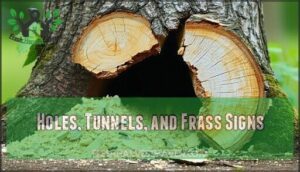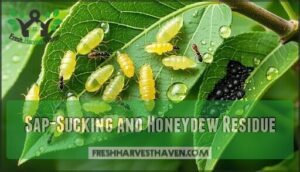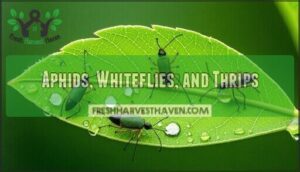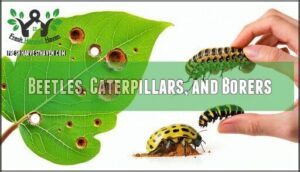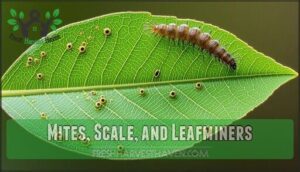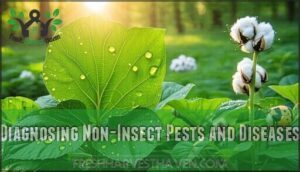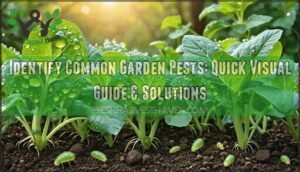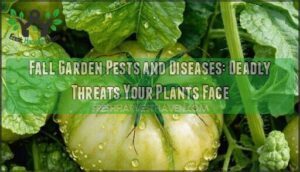This site is supported by our readers. We may earn a commission, at no cost to you, if you purchase through links.
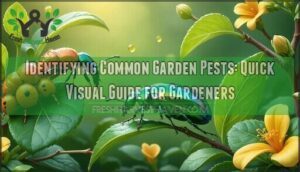 You can spot common garden pests by examining their physical features, damage patterns, and feeding behaviors.
You can spot common garden pests by examining their physical features, damage patterns, and feeding behaviors.
Aphids appear as soft, pear-shaped insects clustering on new growth, while Japanese beetles show distinctive metallic green bodies with copper wings.
Look for specific damage signatures: caterpillars create jagged holes with dark frass beneath plants, spider mites cause stippling on leaf undersides, and borers leave clean circular holes with sawdust-like debris.
Don’t mistake beneficial insects like ladybugs or parasitic wasps for pests—they’re your garden’s natural defenders.
Timing matters too, since pest life cycles determine when they’re most active and vulnerable to control measures, and understanding these cycles can help you identify key moments for intervention, making it easier to protect your garden with the right control measures.
Table Of Contents
- Key Takeaways
- Key Traits of Common Garden Pests
- Recognizing Pest Damage in Your Garden
- Distinguishing Pests From Beneficial Insects
- Identifying Major Insect and Mite Pests
- Diagnosing Non-Insect Pests and Diseases
- Frequently Asked Questions (FAQs)
- How do I identify pests in my garden?
- What is the most common pest in the garden?
- Is there an app to identify garden pests?
- How do I tell what bugs are eating my plants?
- How do I identify my garden pest?
- How do I know what pest my plant has?
- When is the best time to check for pests?
- How long do garden pest infestations typically last?
- Can indoor houseplants get the same garden pests?
- Do garden pests return to the same location?
- Conclusion
Key Takeaways
- Learn the visual clues – You’ll identify pests by their distinct physical features, like aphids’ pear-shaped bodies, Japanese beetles’ metallic green coloring, and spider mites’ tiny specks on leaf undersides.
- Recognize damage patterns – You can spot pest problems through their feeding signatures: caterpillars leave jagged holes with dark frass, borers create clean circular holes with sawdust debris, and sap-suckers produce sticky honeydew residue.
- Don’t eliminate beneficial insects – You’ll protect your garden’s natural defenders by learning to distinguish helpful insects, like ladybugs, lacewings, and parasitic wasps, from actual pests that damage plants.
- Time your inspections strategically – You’ll catch more pests during early morning checks, when nocturnal feeders are still active, and you’ll understand pest life cycles to target interventions at their most vulnerable stages.
Key Traits of Common Garden Pests
Successful pest management starts with accurate identification, since many garden invaders share similar damage patterns but require different control approaches.
You’ll need to examine physical characteristics, life cycle stages, and feeding behaviors to distinguish between beneficial insects and true pests that threaten your plants.
Physical Characteristics and Identification
When examining pest bodies in your garden, you’ll notice distinct physical features that make pest identification straightforward.
Look for key features like body shape, size, and coloration to quickly identify garden troublemakers
Aphids display pear-shaped, soft bodies measuring 1-7 millimeters with long antennae. Japanese beetles showcase metallic green, oval bodies with copper-colored bug wings.
Tomato hornworms reach 10 centimeters with prominent rear horns. Spider mites appear as tiny rounded specks on leaf undersides.
Garden pest control begins with recognizing these larval forms and pest eggs during routine garden bug identification inspections.
Pest Life Cycles and Behavior
Understanding pest behavior helps you spot trouble before damage spreads.
Most common garden pests follow predictable life cycles—eggs, larvae, pupae, then adults—with each stage showing distinct behavioral traits.
Japanese beetles emerge simultaneously in summer, while aphids reproduce continuously during warm months.
Many pests exhibit pest migration patterns, moving between host plants as seasons change.
Recognizing these life stages and pest dispersal behaviors lets you time interventions effectively, which is crucial for understanding complete concepts.
Host Plants and Preferred Environments
Garden pests show distinct Plant Preferences based on their feeding habits and environmental needs.
Every pest targets specific plants based on their unique feeding needs and environmental requirements
Different common garden pests target specific host plants while thriving in particular Soil Types and Microclimates that support their reproduction cycles.
- Vegetable Family Specialists – Colorado potato beetles prefer nightshade plants (tomatoes, potatoes, eggplant), while cabbageworms target brassica crops requiring cool, moist conditions for effective Garden Layout planning.
- Fruit Tree Concentrators – Japanese beetles favor stone fruits and roses in sunny locations, making strategic Crop Rotation essential for garden pest prevention around susceptible ornamental areas.
- Moisture-Dependent Species – Aphids and slugs flourish in humid microclimates with poor air circulation, emphasizing proper spacing in pest management strategies.
Understanding pest control methods is vital for effective garden management and maintaining a healthy ecosystem.
Recognizing Pest Damage in Your Garden
You’ll easily spot pest problems by learning to recognize their telltale damage patterns on your plants.
Each pest group leaves distinct calling cards, from chewed holes and wilting foliage to sticky honeydew deposits and frass trails.
Chewed Leaves and Stems
Chewed leaves tell the story of your garden’s nighttime visitors.
Caterpillars create jagged holes and can strip entire stems, leaving telltale frass signs beneath damaged plants.
Beetles produce distinctive feeding patterns—flea beetles make tiny pinholes while Japanese beetles skeletonize leaves, leaving only veins visible.
Stem borers tunnel internally, causing sudden wilting and tissue loss that’s often discovered too late.
To address these issues, gardeners must understand pest identification methods to effectively manage their gardens and apply proper pest identification to prevent further damage from nighttime visitors and stem borers.
Wilting, Yellowing, and Stunted Growth
When leaves droop like tired shoulders or turn yellow despite adequate watering, you’re likely dealing with root-attacking garden pests or nutrient deficiency issues.
Aphids and root maggots can cause plant stunting by disrupting nutrient uptake, leading to leaf wilting.
Root rot from overwatering creates similar symptoms, while soil depletion manifests as yellowing foliage and stunted growth requiring organic pest control solutions.
Holes, Tunnels, and Frass Signs
Circular holes with clean edges reveal borer signs in stems and trunks, while irregular tunnel damage beneath bark indicates active pest problems.
Look for frass identification clues like sawdust-like droppings near hole patterns, especially around squash vine borers and tree borers.
Garden insects create distinct pest tunnels that compromise plant structure, requiring immediate organic pest control measures.
Sap-Sucking and Honeydew Residue
When sap-sucking insects like aphids, whiteflies, and scale insects feed on your plants, they leave behind sticky honeydew secretions that coat leaves and stems.
This sugary residue attracts ants and promotes sooty mold growth, creating black patches on foliage.
You’ll spot these garden pests clustered on tender shoots, causing yellowing and stunted growth.
Effective whitefly management and aphid control require early detection of these telltale honeydew damage signs.
Distinguishing Pests From Beneficial Insects
You’ll encounter both helpful insects and destructive pests in your garden, but learning to tell them apart saves you from accidentally eliminating your natural allies.
The key lies in observing their behavior, physical features, and the evidence they leave behind on your plants, which is crucial for distinguishing between beneficial and harmful insects.
Ladybugs, Lacewings, and Parasitic Wasps
Beneficial insects are your garden’s natural pest control team.
Ladybugs hunt aphids, whiteflies, and mealybugs, while their larvae consume even more plant pests.
Green lacewings tackle similar targets with delicate wings and golden eyes.
Parasitic wasps lay eggs inside pest insects, providing excellent pest inspection and garden pest solutions.
These garden creatures prefer flowers from daisy and dill families for lacewing habitat and wasp management.
Pollinators Vs. Plant Feeders
While pollinators like bees and butterflies sport fuzzy bodies with specialized mouthparts for nectar feeding, plant feeders display chewing mandibles or piercing stylets designed for consuming plant tissues.
You’ll notice pollinators visiting flowers without damaging foliage, whereas garden pests leave behind chewed leaves, holes, and sticky honeydew residues that signal ecosystem imbalance requiring targeted insect control solutions.
Understanding pollination services is essential for maintaining a healthy garden ecosystem, as seen in the link to pollination services, which highlights the importance of healthy garden and targeted insect control.
Signs of Natural Pest Control
Looking for damage patterns can help you spot when beneficial insects are already controlling pests.
You’ll notice fewer aphids on stems where ladybug larvae have been feeding, or find empty whitefly shells after parasitic wasps emerge.
Mummified aphids signal successful biological controls at work, and these natural barriers reduce your need for organic pesticides, maintaining garden health through effective insect control and pest treatment.
Identifying Major Insect and Mite Pests
Major insect and mite pests share distinctive characteristics that make identification straightforward once you know what to look for.
Learning to recognize these common troublemakers by their physical features, feeding patterns, and damage signatures will help you respond quickly before populations explode in your garden.
Aphids, Whiteflies, and Thrips
Three major sap feeders pose significant threats to your garden health. These tiny invaders cluster on leaf undersides, weakening plants through nutrient extraction and disease transmission.
Key identification features:
- Aphids – Soft, pear-shaped bodies (2-4mm) with distinctive rear cornicles; colors range from green to black
- Whiteflies – Minute white-winged insects (1-2mm) that flutter when disturbed; create powdery residue
- Thrips – Slender, fringed-wing insects producing silvery leaf streaks and black frass specks
- Damage patterns – All three create sticky honeydew, yellowing foliage, and stunted growth
Effective thrip management and whitefly traps complement aphid control strategies. Early detection prevents these garden pests from establishing colonies. Monitor regularly for pest treatment success and maintain garden protection through integrated pest removal approaches and targeted pest advice. Understanding aphid control methods is essential for preventing infestations.
Beetles, Caterpillars, and Borers
Chewed leaves with round holes often signal Colorado potato beetles munching through your nightshade crops.
Caterpillar damage appears as ragged leaf edges and dark frass pellets beneath affected plants.
Garden protection requires early pest identification – examine stems for borer entry holes and sawdust-like frass.
Effective beetle control involves handpicking adults and checking undersides of leaves for orange egg clusters, preventing devastating caterpillar infestations.
Understanding common garden pests is vital for developing a thorough garden protection strategy to prevent devastating infestations.
Mites, Scale, and Leafminers
Four microscopic garden invaders can wreak havoc before you spot them.
Mites create tiny stippled dots on leaves, while scale insects appear as brown bumps on stems. Leafminers leave serpentine trails through foliage, creating distinctive damage patterns that help with pest identification.
- Spider mites – Look for fine webbing and yellow stippling on leaf undersides during hot, dry conditions
- Armored scale – Identify small, waxy bumps clustered on stems that resist removal when scraped
- Leafminer larvae – Recognize winding, white or brown trails between leaf surfaces with visible tunnels
- Soft scale – Spot larger, dome-shaped insects producing sticky honeydew that attracts ants and sooty mold
Diagnosing Non-Insect Pests and Diseases
Not all garden problems come from insects—you’ll encounter fungal diseases that create spots an
Fungal, Viral, and Bacterial Plant Diseases
Plant pathogens present unique challenges beyond insect damage.
Fungal infections appear as powdery coatings, dark spots, or wilting despite adequate watering. Viral outbreaks cause mosaic patterns, yellowing, and stunted growth without visible pathogens.
Bacterial blight creates water-soaked lesions with yellow halos. Environmental factors like humidity increase disease pressure, making disease resistance essential for garden care tips.
Effective fungus control methods involve understanding fungus growth patterns to prevent the spread of disease.
Animal Pests: Deer, Moles, and Rodents
Larger animal pests present unique challenges requiring targeted identification techniques.
Deer damage appears as cleanly browsed foliage at shoulder height, while mole activity creates raised tunnel networks beneath your lawn surface.
Rodent deterrents work best when you identify burrow management needs early, and wildlife fencing protects vulnerable crops from deer control issues.
Mole traps target specific runway patterns these mammals create underground.
Preventive Measures and Early Detection
Beyond managing animal damage, successful prevention requires ongoing vigilance.
Weekly Pest Monitoring helps spot issues before they spread. Crop Rotation disrupts pest life cycles, while Soil Testing reveals nutrient imbalances that weaken plants.
Smart Irrigation Management prevents overwatering that attracts pests. You’ll identify problems faster by checking identifying details like unusual holes or discoloration during routine garden walks.
Effective garden management also involves understanding pest control methods to protect your garden from common threats and requires ongoing efforts to maintain a healthy garden through successful prevention strategies.
Frequently Asked Questions (FAQs)
How do I identify pests in my garden?
Like a detective examining clues, you’ll identify garden pests by observing damage patterns, examining affected plant parts, and noting feeding behaviors.
Look for chewed leaves, stippled foliage, or wilting plants, then match symptoms to common culprits.
What is the most common pest in the garden?
Aphids are likely your garden’s most common pest. These tiny, soft-bodied insects cluster on new growth, sucking plant juices and reproducing rapidly, affecting virtually every plant type you’ll grow.
Is there an app to identify garden pests?
Yes, several apps can identify garden pests using AI.
They include Picture Insect, which uses AI technology – simply take a photo, and Agrio, which identifies plant diseases.
Plantix diagnoses plant health problems with machine learning.
How do I tell what bugs are eating my plants?
Your garden’s detective work starts with examining damage patterns.
Look for holes in leaves (beetles, caterpillars), stippled yellowing (mites), sticky honeydew (aphids), or wilting stems (borers).
Check underneath leaves and around plant bases for the culprits themselves.
How do I identify my garden pest?
Look for specific damage patterns like holes in leaves, wilting plants, or visible insects.
Check leaf undersides, stems, and soil around roots.
Note the timing and location of damage, then match symptoms to common pest behaviors and feeding patterns, which can help identify the cause of the problem, such as insects.
How do I know what pest my plant has?
Examine damaged leaves, stems, and fruits closely. Check for distinctive signs like holes, stippling, webbing, or sticky residue. Note pest location, timing, and host plants to narrow identification.
When is the best time to check for pests?
Early morning hours offer the best pest detection opportunities. You’ll catch nocturnal feeders like cutworms and slugs before they hide, while beneficial insects haven’t yet arrived to confuse identification.
How long do garden pest infestations typically last?
Picture waves of tiny invaders washing over your plants like a living tide.
Infestation duration varies dramatically: aphids multiply rapidly in 7-14 days, while borers persist for months.
You’ll see quick-breeding pests crash within weeks, but persistent species require sustained management throughout growing seasons.
Can indoor houseplants get the same garden pests?
Yes, houseplants can get many of the same pests as garden plants.
Aphids, spider mites, whiteflies, thrips, and scale insects commonly infest indoor plants, especially when conditions are warm and humid indoors, with aphids being a common issue.
Do garden pests return to the same location?
Research shows 80% of pest species exhibit site fidelity, returning to favorable locations.
You’ll find many garden pests like aphids, Japanese beetles, and caterpillars return because they recognize host plants, pheromone trails, and suitable microhabitats from previous seasons, which is due to their ability to recognize favorable locations.
Conclusion
Ironically, after mastering identifying common garden pests through visual cues and damage patterns, you’ll discover the real challenge isn’t spotting them—it’s accepting their inevitable presence.
Your newfound expertise in recognizing aphid clusters, beetle feeding damage, and mite stippling will transform you from reactive gardener to proactive pest manager.
You’ll differentiate beneficial insects from destructive ones, timing interventions perfectly with pest life cycles. This systematic approach to pest identification empowers confident garden management decisions, leading to a more proactive gardener.



